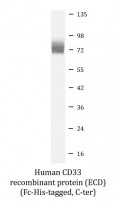ARG70263
Human CD33 recombinant protein (ECD) (Fc-His-tagged, C-ter)
Human CD33 recombinant protein (ECD) (Fc-His-tagged, C-ter) for Binding Activity,ELISA,SDS-PAGE and Human
Overview
| Product Description | HEK293 expressed, Fc-His-tagged (C-ter) Human CD33 recombinant protein (ECD). |
|---|---|
| Tested Reactivity | Hu |
| Tested Application | Binding, ELISA, SDS-PAGE |
| Target Name | CD33 (ECD) |
| Species | Human |
| A.A. Sequence | Asp18 - His259 of Human CD33 (NP_001763.3) with an Fc-6X His tag at the C-terminus. |
| Expression System | HEK293 |
| Alternate Names | p67; Sialic acid-binding Ig-like lectin 3; SIGLEC-3; CD antigen CD33; gp67; Siglec-3; Myeloid cell surface antigen CD33; SIGLEC3 |
Application Instructions
| Application Note | Binding activity test: Measured by its binding ability in a functional ELISA. Immobilized Human CD33 at 2 µg/ml (100 µl/well) can bind Anti-Human CD33 Antibody with a linear range of 8-20 ng/ml. |
|---|
Properties
| Form | Powder |
|---|---|
| Purification Note | 0.22 µm filter sterilized. Endotoxin level is <0.1 EU/µg of the protein, as determined by the LAL test. |
| Purity | >97% (by SDS-PAGE) |
| Buffer | PBS (pH 7.4) |
| Reconstitution | Reconstitute to a concentration of 0.1 - 0.5 mg/ml in sterile distilled water. |
| Storage Instruction | For long term, lyophilized protein should be stored at -20°C or -80°C. After reconstitution, aliquot and store at -20°C for up to one month, at 2-8°C for up to one week. Storage in frost free freezers is not recommended. Avoid repeated freeze/thaw cycles. Suggest spin the vial prior to opening. |
| Note | For laboratory research only, not for drug, diagnostic or other use. |
Bioinformation
| Gene Symbol | CD33 |
|---|---|
| Gene Full Name | CD33 molecule |
| Function | Sialic-acid-binding immunoglobulin-like lectin (Siglec) that plays a role in mediating cell-cell interactions and in maintaining immune cells in a resting state (PubMed:10611343, PubMed:15597323, PubMed:11320212). Preferentially recognizes and binds alpha-2,3- and more avidly alpha-2,6-linked sialic acid-bearing glycans (PubMed:7718872). Upon engagement of ligands such as C1q or syalylated glycoproteins, two immunoreceptor tyrosine-based inhibitory motifs (ITIMs) located in CD33 cytoplasmic tail are phosphorylated by Src-like kinases such as LCK (PubMed:28325905, PubMed:10887109). These phosphorylations provide docking sites for the recruitment and activation of protein-tyrosine phosphatases PTPN6/SHP-1 and PTPN11/SHP-2 (PubMed:10556798, PubMed:10206955, PubMed:10887109). In turn, these phosphatases regulate downstream pathways through dephosphorylation of signaling molecules (PubMed:10206955, PubMed:10887109). One of the repressive effect of CD33 on monocyte activation requires phosphoinositide 3-kinase/PI3K (PubMed:15597323). [UniProt] |
| Cellular Localization | Cell membrane; Single-pass type I membrane protein. [UniProt] |
| Calculated MW | 40 kDa |
| PTM | Phosphorylation of Tyr-340 is involved in binding to PTPN6 and PTPN11. Phosphorylation of Tyr-358 is involved in binding to PTPN6. [UniProt] |
Images (2) Click the Picture to Zoom In
-
ARG70263 Human CD33 recombinant protein (ECD) (Fc-His-tagged, C-ter) ELISA image
ELISA: The plate was coated with ARG70263 Human CD33 recombinant protein (ECD) (Fc-His-tagged, C-ter) at 2 µg/ml (100 µl/well). Samples were detected with serially diluted anti-CD33 antibody.
-
ARG70263 Human CD33 recombinant protein (ECD) (Fc-His-tagged, C-ter) SDS-PAGE image
SDS-PAGE analysis of ARG70263 Human CD33 recombinant protein (ECD) (Fc-His-tagged, C-ter).







